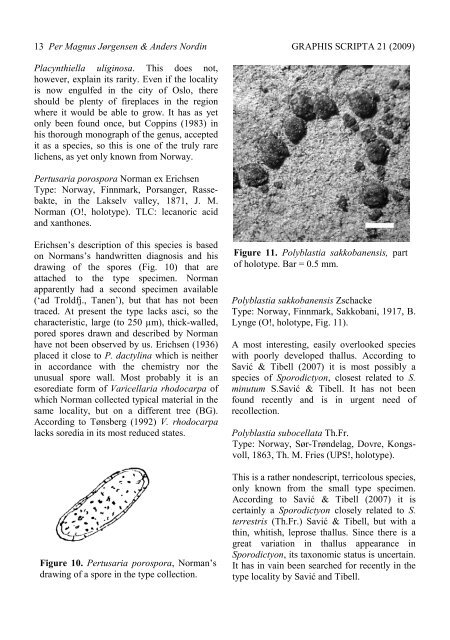(2009): Lichens in Scandinavia known mainly from Norwegian type ...
(2009): Lichens in Scandinavia known mainly from Norwegian type ...
(2009): Lichens in Scandinavia known mainly from Norwegian type ...
You also want an ePaper? Increase the reach of your titles
YUMPU automatically turns print PDFs into web optimized ePapers that Google loves.
13 Per Magnus Jørgensen & Anders Nord<strong>in</strong> GRAPHIS SCRIPTA 21 (<strong>2009</strong>)<br />
Placynthiella ulig<strong>in</strong>osa. This does not,<br />
however, expla<strong>in</strong> its rarity. Even if the locality<br />
is now engulfed <strong>in</strong> the city of Oslo, there<br />
should be plenty of fireplaces <strong>in</strong> the region<br />
where it would be able to grow. It has as yet<br />
only been found once, but Copp<strong>in</strong>s (1983) <strong>in</strong><br />
his thorough monograph of the genus, accepted<br />
it as a species, so this is one of the truly rare<br />
lichens, as yet only <strong>known</strong> <strong>from</strong> Norway.<br />
Pertusaria porospora Norman ex Erichsen<br />
Type: Norway, F<strong>in</strong>nmark, Porsanger, Rassebakte,<br />
<strong>in</strong> the Lakselv valley, 1871, J. M.<br />
Norman (O!, holo<strong>type</strong>). TLC: lecanoric acid<br />
and xanthones.<br />
Erichsen’s description of this species is based<br />
on Normans’s handwritten diagnosis and his<br />
draw<strong>in</strong>g of the spores (Fig. 10) that are<br />
attached to the <strong>type</strong> specimen. Norman<br />
apparently had a second specimen available<br />
(‘ad Troldfj., Tanen’), but that has not been<br />
traced. At present the <strong>type</strong> lacks asci, so the<br />
characteristic, large (to 250 µm), thick-walled,<br />
pored spores drawn and described by Norman<br />
have not been observed by us. Erichsen (1936)<br />
placed it close to P. dactyl<strong>in</strong>a which is neither<br />
<strong>in</strong> accordance with the chemistry nor the<br />
unusual spore wall. Most probably it is an<br />
esorediate form of Varicellaria rhodocarpa of<br />
which Norman collected typical material <strong>in</strong> the<br />
same locality, but on a different tree (BG).<br />
Accord<strong>in</strong>g to Tønsberg (1992) V. rhodocarpa<br />
lacks soredia <strong>in</strong> its most reduced states.<br />
Figure 10. Pertusaria porospora, Norman’s<br />
draw<strong>in</strong>g of a spore <strong>in</strong> the <strong>type</strong> collection.<br />
Figure 11. Polyblastia sakkobanensis, part<br />
of holo<strong>type</strong>. Bar = 0.5 mm.<br />
Polyblastia sakkobanensis Zschacke<br />
Type: Norway, F<strong>in</strong>nmark, Sakkobani, 1917, B.<br />
Lynge (O!, holo<strong>type</strong>, Fig. 11).<br />
A most <strong>in</strong>terest<strong>in</strong>g, easily overlooked species<br />
with poorly developed thallus. Accord<strong>in</strong>g to<br />
Savić & Tibell (2007) it is most possibly a<br />
species of Sporodictyon, closest related to S.<br />
m<strong>in</strong>utum S.Savić & Tibell. It has not been<br />
found recently and is <strong>in</strong> urgent need of<br />
recollection.<br />
Polyblastia subocellata Th.Fr.<br />
Type: Norway, Sør-Trøndelag, Dovre, Kongsvoll,<br />
1863, Th. M. Fries (UPS!, holo<strong>type</strong>).<br />
This is a rather nondescript, terricolous species,<br />
only <strong>known</strong> <strong>from</strong> the small <strong>type</strong> specimen.<br />
Accord<strong>in</strong>g to Savić & Tibell (2007) it is<br />
certa<strong>in</strong>ly a Sporodictyon closely related to S.<br />
terrestris (Th.Fr.) Savić & Tibell, but with a<br />
th<strong>in</strong>, whitish, leprose thallus. S<strong>in</strong>ce there is a<br />
great variation <strong>in</strong> thallus appearance <strong>in</strong><br />
Sporodictyon, its taxonomic status is uncerta<strong>in</strong>.<br />
It has <strong>in</strong> va<strong>in</strong> been searched for recently <strong>in</strong> the<br />
<strong>type</strong> locality by Savić and Tibell.

















